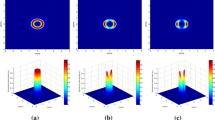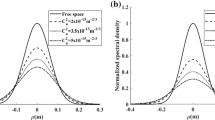Abstract
A numerical simulation-based algorithm is proposed for calculating the backscatter amplification (BSA) coefficient of laser radiation propagating in a turbulent atmosphere. The algorithm permits one to obtain results for conditions under which the known analytical calculation methods are inapplicable. Using this algorithm, the BSA coefficient is analyzed numerically for different conditions of laser radiation propagation in the atmosphere.
Similar content being viewed by others
References
A. G. Vinogradov, Yu. A. Kravtsov, and V. I. Tatarskii, “The Effect of Intensification of Back Scattering by Bodies That Are Situated in a Medium Having Random Inhomogeneities,” Radiophys. Quant. Electr. 16(7), 818–823 (1973).
A. S. Gurvich and S. S. Kashkarov, “Problem of Enhancement of Scattering in a Turbulent Medium,” Radiophys. Quant. Electr. 20(5), 547–549 (1977).
Yu. A. Kravtsov and A. I. Saichev, “Effects of Double Passage of Waves in Randomly Inhomogeneous Media,” Physics-Uspekhi 25(7), 494–508 (1982).
V. A. Banakh and V. L. Mironov, Lidar in a Turbulent Atmosphere (Artech House, Boston and London, 1987).
A. S. Gurvich, “Lidar Sounding of Turbulence Based on the BSA Effect,” Izvestiya, Atmos. Ocean. Phys. (in press).
A. S. Gurvich, RF Patent No. 20 (2012).
A. L. Afanas’ev, A. S. Gurvich, and A. P. Rostov, “Experimental Study of the BSA Effect in a Turbuelnt Atmosphere,” in Proc. of the XVIII Intern. Symp. “Atmospheric and Ocean Optics. Atmospheric Physics”, Irkutsk, 2012 (Publishing House of IAO SB RAS, Tomsk, 2012) [in Russian].
V. A. Banakh, “Enhancement of the Laser Return Mean Power at the Strong Optical Scintillation Regime in a Turbulent Atmosphere,” Atmos. Ocean. Opt. 26(2), (2013).
V. P. Kandidov, “Monte Carlo Method in Nonlinear Statistical Optics,” Physics-Uspekhi 39(12), 1243–1272 (1996).
R. Frehlich, “Simulation of Laser Propagation in a Turbulent Atmosphere,” Appl. Opt. 39(3), 393–397 (2000).
A. Belmonte, “Feasibility Study for the Simulation of Beam Propagation: Consideration of Coherent Lidar Performance,” Appl. Opt. 39(30), 542–5445 (2000).
V. A. Banakh, I. N. Smalikho, and A. V. Falits, “Effectiveness of the Subharmonic Method in Problems of Computer Simulation of Laser Beam Propagation in a Turbulent Atmosphere,” Atmos. Ocean. Opt. 25(2), 106–109 (2012).
P. A. Konyaev, E. A. Tartakovskii, and G. A. Filimonov, “Computer Simulation of Optical Wave Propagation with the Use of Parallel Programming,” Atmos. Ocean. Opt. 24(5), 425–431 (2011).
A. Belmonte and B. J. Rye, “Heterodyne Lidar Returns in the Turbulent Atmosphere: Performance Evaluation of Simulated Systems,” Appl. Opt. 39(15), 2401–2411 (2000).
R. G. Frehlich, “Effect of Refractive Turbulence on Ground-Based Verification of Coherent Doppler Lidar Performance,” Appl. Opt. 39(24), 4237–4246 (2000).
V. A. Banakh, I. N. Smalikho, and Ch. Werner, “Numerical Simulation of Effect of Refractive Turbulence on the Statistics of a Coherent Lidar Return in the Atmosphere,” Appl. Opt. 39(30), 5403–5414 (2000).
V. A. Banakh and I. N. Smalikho, “Determination of Optical Turbulence Intensity by Atmospheric Backscattering of Laser Radiation,” Atmos. Ocean. Opt. 24(5), 457–465 (2011).
V. I. Tatarskii, Wave Propagation in Turbulent Atmosphere (Nauka, Moscow, 1967) [in Russian].
A. S. Gurvich, A. I. Kon, V. L. Mironov, and S. S. Khmelevtsov, Laser Radiation in Turbulent Atmosphere (Nauka, Moscow, 1976) [in Russian].
V. E. Zuev, V. A. Banakh, and V. V. Pokasov, Modern Problems of Atmospheric Optics. Vol. 5. Optics of Turbulent Atmosphere (Gidrometeoizdat, Leningrad, 1988) [in Russian].
A. Zilberman and N. S. Kopeika, “Lidar Measurements of Atmospheric Turbulence Profiles,” Proc. SPIE 5338, 288–297 (2004).
Author information
Authors and Affiliations
Corresponding author
Additional information
Original Russian Text © I.N. Smalikho, 2013, published in Optica Atmosfery i Okeana.
Rights and permissions
About this article
Cite this article
Smalikho, I.N. Calculation of the backscatter amplification coefficient of laser radiation propagating in a turbulent atmosphere using numerical simulation. Atmos Ocean Opt 26, 135–139 (2013). https://doi.org/10.1134/S1024856013020127
Received:
Published:
Issue Date:
DOI: https://doi.org/10.1134/S1024856013020127




